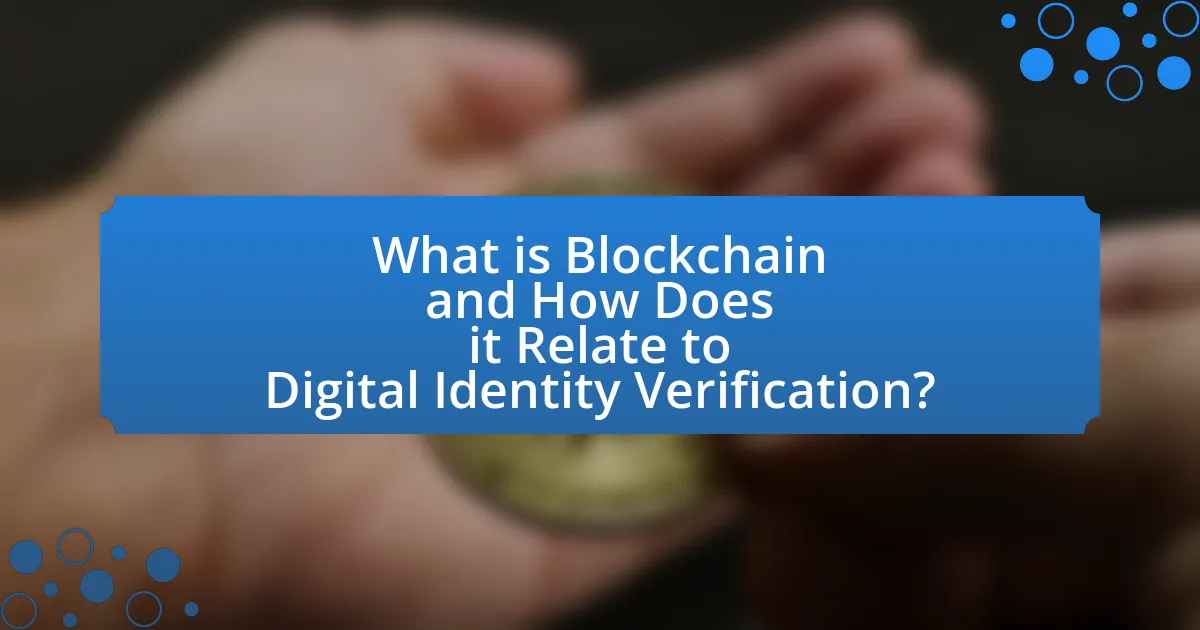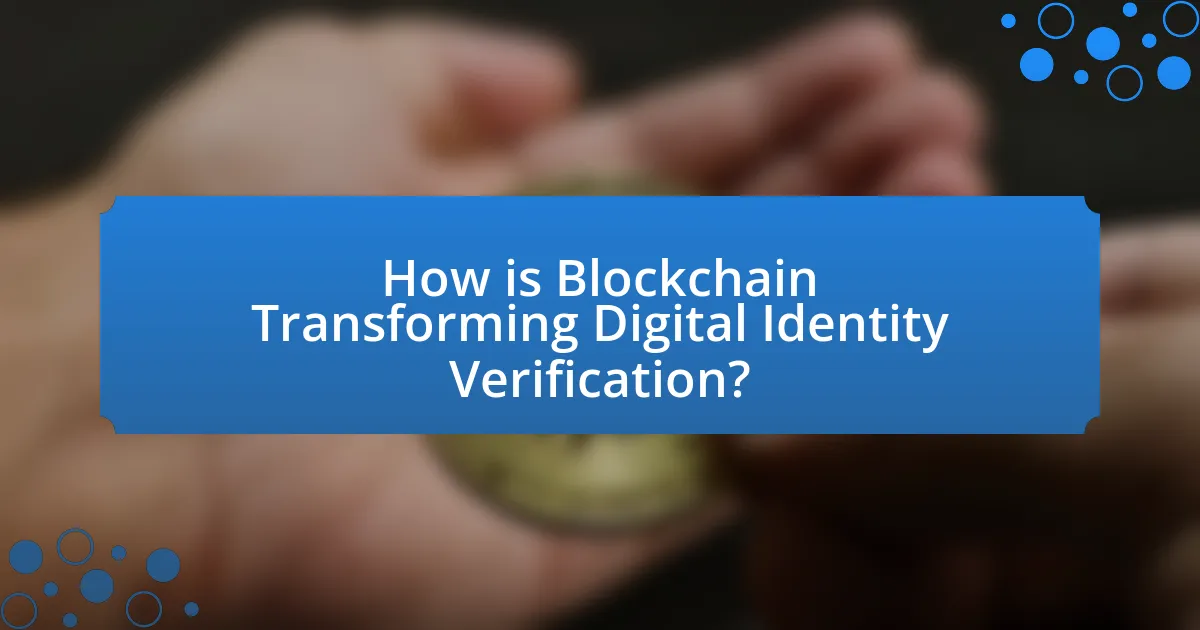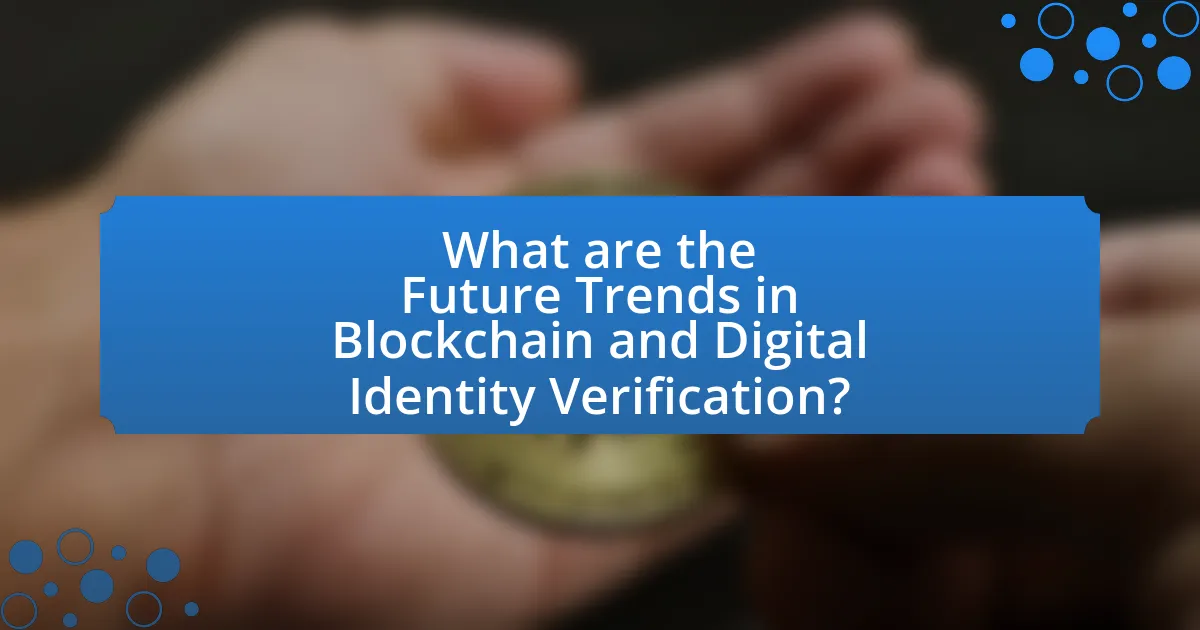Blockchain is a decentralized digital ledger technology that enhances digital identity verification by securely recording and managing identity credentials. This technology allows individuals to control their personal data, reducing the risks of identity theft and fraud through features such as decentralization, immutability, and transparency. The article explores how blockchain functions in identity verification, the challenges faced by traditional methods, and the benefits of adopting blockchain solutions across various sectors, including finance and healthcare. Additionally, it discusses future trends, regulatory considerations, and best practices for organizations implementing blockchain for identity verification.

What is Blockchain and How Does it Relate to Digital Identity Verification?
Blockchain is a decentralized digital ledger technology that securely records transactions across multiple computers, ensuring that the data cannot be altered retroactively without the consensus of the network. This technology relates to digital identity verification by providing a secure and immutable way to store and manage identity credentials, allowing individuals to control their own data and share it selectively with trusted parties. For instance, blockchain can facilitate the creation of self-sovereign identities, where users can verify their identity without relying on a central authority, thus reducing the risk of identity theft and fraud. The use of cryptographic techniques in blockchain enhances the security and privacy of personal information, making it a robust solution for digital identity verification.
How does blockchain technology function in the context of identity verification?
Blockchain technology functions in identity verification by providing a decentralized and immutable ledger that securely stores and verifies identity data. This technology allows individuals to control their own identity information, reducing the risk of identity theft and fraud. Each identity is represented as a unique cryptographic hash on the blockchain, ensuring that any changes to the data are transparent and traceable. For instance, a study by the World Economic Forum in 2020 highlighted that blockchain can enhance identity verification processes by enabling secure digital identities that are easily verifiable without relying on a central authority. This decentralized approach not only increases security but also improves efficiency in identity verification processes across various sectors.
What are the key features of blockchain that enhance identity verification?
The key features of blockchain that enhance identity verification include decentralization, immutability, and transparency. Decentralization allows for identity data to be stored across a network of nodes, reducing the risk of a single point of failure or data breach. Immutability ensures that once identity information is recorded on the blockchain, it cannot be altered or deleted, providing a reliable and tamper-proof record. Transparency enables all participants in the network to access and verify identity information, fostering trust and accountability. These features collectively enhance the security and reliability of identity verification processes.
How does decentralization in blockchain improve security for digital identities?
Decentralization in blockchain enhances security for digital identities by distributing data across a network of nodes rather than storing it in a single, centralized location. This distribution reduces the risk of data breaches, as there is no single point of failure that can be targeted by attackers. Additionally, blockchain employs cryptographic techniques to secure identity information, ensuring that only authorized users can access or modify their data. For instance, a study by the World Economic Forum highlights that decentralized identity systems can significantly lower the chances of identity theft and fraud, as they provide users with greater control over their personal information and reduce reliance on third-party intermediaries.
What challenges does traditional digital identity verification face?
Traditional digital identity verification faces several challenges, including security vulnerabilities, data privacy concerns, and inefficiencies in the verification process. Security vulnerabilities arise from the reliance on centralized databases, which are susceptible to hacking and data breaches; for instance, the 2017 Equifax breach exposed sensitive information of approximately 147 million individuals. Data privacy concerns stem from the collection and storage of personal information by third parties, leading to potential misuse or unauthorized access. Additionally, inefficiencies occur due to the lengthy verification processes that often require multiple steps and manual intervention, resulting in delays and increased costs for both users and service providers.
Why is data privacy a concern in conventional identity verification methods?
Data privacy is a concern in conventional identity verification methods because these methods often require the collection and storage of sensitive personal information, which can be vulnerable to breaches. For instance, traditional systems may store data such as Social Security numbers, addresses, and financial information in centralized databases, making them attractive targets for cyberattacks. According to a report by the Identity Theft Resource Center, there were over 1,100 data breaches in the United States in 2020 alone, exposing millions of individuals’ personal data. This highlights the risk of unauthorized access and misuse of personal information, leading to identity theft and privacy violations.
How do identity theft and fraud impact users and organizations?
Identity theft and fraud significantly harm both users and organizations by leading to financial losses, reputational damage, and legal consequences. Users often face direct financial losses, with the Federal Trade Commission reporting that identity theft resulted in over $1.9 billion in losses in 2020 alone. Organizations suffer from increased operational costs due to fraud prevention measures, potential fines, and loss of customer trust, which can lead to decreased revenue. Additionally, a study by the Ponemon Institute found that the average cost of a data breach for organizations was $3.86 million in 2020, highlighting the extensive financial impact of identity-related crimes.

How is Blockchain Transforming Digital Identity Verification?
Blockchain is transforming digital identity verification by providing a decentralized and secure method for managing identities. This technology enables individuals to control their personal information, reducing the risk of identity theft and fraud. For instance, blockchain allows users to create a digital identity that is cryptographically secured and can be verified without relying on a central authority. According to a report by the World Economic Forum, blockchain can reduce identity verification costs by up to 50% while increasing security and privacy. This shift not only enhances user trust but also streamlines processes across various sectors, including finance and healthcare, where identity verification is critical.
What are the primary benefits of using blockchain for identity verification?
The primary benefits of using blockchain for identity verification include enhanced security, increased privacy, and improved efficiency. Blockchain technology provides a decentralized and tamper-proof ledger, which significantly reduces the risk of identity theft and fraud. According to a study by the World Economic Forum, blockchain can reduce identity fraud by up to 80% due to its immutable nature. Additionally, users have greater control over their personal data, allowing them to share only necessary information without relying on centralized authorities. This not only protects user privacy but also streamlines the verification process, making it faster and more cost-effective.
How does blockchain enhance user control over personal data?
Blockchain enhances user control over personal data by enabling decentralized storage and management of information. This technology allows individuals to own and manage their data without relying on centralized authorities, reducing the risk of unauthorized access and data breaches. For instance, through cryptographic techniques, users can grant and revoke access to their personal data selectively, ensuring that only authorized parties can view or use their information. Additionally, blockchain’s immutable ledger provides a transparent record of data transactions, allowing users to track how their data is used and shared. This level of transparency and control empowers users to make informed decisions regarding their personal information, ultimately enhancing their privacy and security.
What role does transparency play in blockchain-based identity verification?
Transparency is crucial in blockchain-based identity verification as it ensures that all transactions and identity claims are publicly accessible and immutable. This characteristic allows users to verify the authenticity of identity information without relying on a central authority, thereby reducing the risk of fraud and identity theft. For instance, blockchain’s decentralized ledger records every transaction in a way that is visible to all participants, which enhances trust among users. According to a study by the World Economic Forum, the transparency provided by blockchain technology can significantly improve the efficiency and security of identity verification processes, as it allows for real-time auditing and validation of identity claims.
How do different industries implement blockchain for identity verification?
Different industries implement blockchain for identity verification by utilizing decentralized ledgers to enhance security, transparency, and efficiency in managing identities. For instance, the financial sector employs blockchain to streamline Know Your Customer (KYC) processes, allowing institutions to share verified customer identities securely, reducing redundancy and fraud risks. The healthcare industry uses blockchain to maintain secure patient records, enabling authorized personnel to access verified identities while ensuring data integrity and privacy. In the public sector, governments are exploring blockchain for issuing digital IDs, which can simplify access to services and reduce identity theft. These implementations demonstrate blockchain’s capability to provide a secure, immutable, and efficient method for identity verification across various sectors.
What examples exist of blockchain applications in the financial sector?
Blockchain applications in the financial sector include cross-border payments, smart contracts, and decentralized finance (DeFi) platforms. Cross-border payments utilize blockchain to facilitate faster and cheaper transactions by eliminating intermediaries, with companies like Ripple leading this innovation. Smart contracts automate and enforce agreements without the need for a central authority, exemplified by Ethereum’s platform. DeFi platforms, such as Uniswap and Aave, enable users to lend, borrow, and trade assets directly on the blockchain, enhancing financial accessibility and efficiency. These applications demonstrate how blockchain technology is transforming traditional financial processes.
How is blockchain being utilized in healthcare for identity verification?
Blockchain is utilized in healthcare for identity verification by providing a secure, decentralized method to manage and authenticate patient identities. This technology enables healthcare providers to create immutable records of patient identities, ensuring that only authorized individuals can access sensitive health information. For instance, a study published in the Journal of Medical Internet Research highlights that blockchain can reduce identity fraud and streamline patient onboarding processes by allowing patients to control their own identity data. This decentralized approach enhances trust and security in healthcare transactions, as it minimizes the risk of data breaches and unauthorized access.

What are the Future Trends in Blockchain and Digital Identity Verification?
Future trends in blockchain and digital identity verification include the increased adoption of decentralized identity solutions, enhanced privacy features, and integration with artificial intelligence. Decentralized identity solutions allow individuals to control their own identity data, reducing reliance on centralized authorities. Enhanced privacy features, such as zero-knowledge proofs, enable users to verify their identity without revealing sensitive information. Integration with artificial intelligence can streamline identity verification processes, improving efficiency and accuracy. According to a report by Gartner, by 2025, 30% of organizations will use decentralized identity solutions, reflecting a significant shift towards more secure and user-centric identity verification methods.
How is the regulatory landscape evolving for blockchain identity solutions?
The regulatory landscape for blockchain identity solutions is evolving towards increased clarity and standardization. Governments and regulatory bodies are beginning to establish frameworks that address the unique challenges posed by blockchain technology, such as data privacy, security, and user consent. For instance, the European Union’s General Data Protection Regulation (GDPR) has prompted discussions on how blockchain can comply with data protection laws while maintaining transparency and immutability. Additionally, initiatives like the U.S. National Institute of Standards and Technology (NIST) are working on guidelines for digital identity management that incorporate blockchain technology, indicating a move towards formal recognition and integration of blockchain identity solutions within existing regulatory structures.
What potential legal challenges could arise with blockchain identity verification?
Potential legal challenges with blockchain identity verification include issues related to data privacy, compliance with regulations, and the immutability of recorded information. Data privacy concerns arise because blockchain technology often involves the storage of personal information in a decentralized manner, which may conflict with laws such as the General Data Protection Regulation (GDPR) that require individuals to have control over their personal data. Compliance challenges stem from the need to adhere to various jurisdictional laws governing identity verification processes, which can vary significantly across regions. Additionally, the immutability of blockchain records can pose legal risks if incorrect or fraudulent information is recorded, as it becomes difficult to amend or delete such data without consensus from all parties involved. These challenges highlight the need for careful consideration of legal frameworks when implementing blockchain for identity verification.
How might advancements in technology influence blockchain identity verification?
Advancements in technology significantly enhance blockchain identity verification by improving security, scalability, and user experience. For instance, the integration of artificial intelligence can streamline the verification process by automating identity checks and detecting fraudulent activities in real-time. Additionally, the development of quantum computing poses both challenges and opportunities for encryption methods used in blockchain, potentially leading to more robust security protocols. Furthermore, advancements in biometric technologies, such as facial recognition and fingerprint scanning, can be seamlessly integrated with blockchain systems to provide a higher level of identity assurance. These technological improvements collectively contribute to a more efficient, secure, and user-friendly identity verification process on blockchain platforms.
What best practices should organizations follow when adopting blockchain for identity verification?
Organizations should prioritize data privacy, interoperability, and user consent when adopting blockchain for identity verification. Implementing strong encryption methods ensures that sensitive identity information remains secure, while interoperability with existing systems allows for seamless integration and broader acceptance. Additionally, obtaining explicit user consent for data usage fosters trust and compliance with regulations such as GDPR. These practices are essential for creating a robust and reliable identity verification system that leverages blockchain technology effectively.
How can organizations ensure compliance with data protection regulations?
Organizations can ensure compliance with data protection regulations by implementing robust data governance frameworks that include regular audits, employee training, and the use of encryption technologies. These frameworks help organizations identify and mitigate risks associated with data handling, ensuring adherence to regulations such as the General Data Protection Regulation (GDPR) and the California Consumer Privacy Act (CCPA). For instance, a study by the International Association of Privacy Professionals (IAPP) found that organizations with comprehensive data protection strategies are 50% more likely to avoid data breaches, thereby demonstrating the effectiveness of proactive compliance measures.
What strategies can enhance user trust in blockchain identity solutions?
To enhance user trust in blockchain identity solutions, implementing transparency, robust security measures, and user education is essential. Transparency can be achieved by providing clear information about how identity data is stored, accessed, and managed on the blockchain, which helps users understand the system’s workings. Robust security measures, such as encryption and multi-factor authentication, protect user data from unauthorized access, thereby increasing confidence in the solution. User education initiatives, including tutorials and resources that explain the benefits and functionalities of blockchain identity solutions, empower users to make informed decisions, further solidifying their trust. According to a study by the World Economic Forum, transparency and security are critical factors influencing user trust in digital identity systems.


